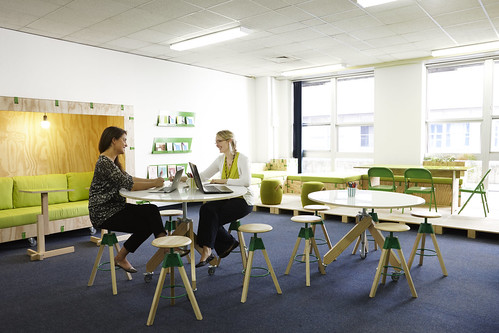
How many meetings and conference calls did you have yesterday? Our work days are filled with meetings and conference calls with the intent of getting stuff done. But many meetings end up being a complete waste of time.
That’s why we included a module in the Emerging Nonprofit Leaders peer learning group on meeting design and facilitation – and these days it is an important leadership skill. In preparation, I’ve been studying the research and best practices for productive meetings. Here’s a summary of what I learned:
Do You Have The Basics of Good Meetings Covered?
If you want the basics about holding a meeting that is energizing instead of draining, here is a good summary from the Harvard Business Review: “What Everyone Needs to Know About Running Productive Meetings.” Many of these practices are used at companies that pride themselves in having productive meetings. Andrea Kihlstedt and I gave a webinar for Guidestar on healthy and productive nonprofit meetings. Our tips are here.
The best advice is to ask yourself if you need to schedule a meeting in the first place. The HBR article has a handy decision-making tree. If you can’t get by with fewer meetings, try to make them shorter. Don’t fall into the trap scheduling a meeting for one-hour by default. Try scheduling them for 30, or 15 minutes. What happens is that you stay focused and waste less time.
What Research Says About Productive Meetings and Conference Calls
Many of our meetings take place on conference calls. Intercall did some research about what people actually do on a conference call. As we may all suspect, people are often multi-tasking. Probably because a lot of meeting isn’t relevant for them – so why make people stay on the call the whole time?
That got me curious if there was more recent data on effective meeting and conference call practice, especially face-to-face meetings and hybrids (some people are face-to-face and others are remote). The Buffer Blog recently published a post, “Nine Science-Backed Methods for Happier, Productive Meetings,” that summarized new research and actionable tips for better meetings, including some tips that were new and different – and very useful:
Don’t Take Notes with Your Laptop
The Buffer Blog article suggests that taking hand-written notes is more effective than typing notes on a laptop. They point to one of many studies that seem to indicate that when people write notes by hand, they improve their recall and understanding of the concepts. When I asked several well-respected educators about this, some mentioned that simply listening actively is even better, although that probably isn’t practical in the workplace.
I think that hand written notes at meetings versus laptop are better because we are engaged with each other and don’t have our noses in a screen and the temptation to multi-task. It forces us to do better active listening.
A Table Stack for Cell Phones
In the article, they suggest creating a coat-check for cell phones. It’s where people put their phones in a pile with a sticky note with their name on it. This technique, also known as a phone stack, has become popular for business meetings, lunches, and even family time. It takes away multi-tasking on your phone and lets you focus on the meeting agenda and what people are saying, making it more productive.
Take the Chairs Away
This tip is about standing meetings, where everyone stands during the meeting which is typically 15-30 minutes. Standing meetings are popular for check-ins on projects, especially at start-up companies. Here’s good tips about how to hold a standing meeting.
The Buffer post points to some research about the benefits of standing meetings. Andrew Knight and Markus Baer of Washington University conducted a study on stand-up meetings versus sit-down meetings, rating the ability of participants to work together, share ideas, and produce quality work. They measured these different elements using surveys, observation, and physiological sensors. The bottom line: Standing meetings can enhance creativity and collaboration.
The same holds true for walking meetings. I’ve written many blog posts with practical tips about walking meetings and reviewed the research literature. Walking meetings, like standing meetings, also encourage creativity and collaboration according to this research from Stanford.
What unusual tips and practices have you used to have more productive meetings at your nonprofit?
Beth Kanter is a consultant, author, influencer. virtual trainer & nonprofit innovator in digital transformation & workplace wellbeing.
